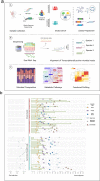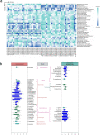Transcriptionally active nasopharyngeal commensals and opportunistic microbial dynamics define mild symptoms in the COVID 19 vaccination breakthroughs
- PMID: 36800345
- PMCID: PMC9937460
- DOI: 10.1371/journal.ppat.1011160
Transcriptionally active nasopharyngeal commensals and opportunistic microbial dynamics define mild symptoms in the COVID 19 vaccination breakthroughs
Abstract
The development of COVID 19 vaccines as an effort to mitigate the outbreak, has saved millions of lives globally. However, vaccination breakthroughs have continuously challenged the vaccines' effectiveness and provided incentives to explore facets holding potential to alter vaccination-induced immunity and protection from subsequent infection, especially VOCs (Variants Of Concern). We explored the functional dynamics of nasopharyngeal transcriptionally active microbes (TAMs) between vaccination breakthroughs and unvaccinated SARS-CoV-2 infected individuals. Microbial taxonomic communities were differentially altered with skewed enrichment of bacterial class/genera of Firmicutes and Gammaproteobacteria with grossly reduced phylum Bacteroidetes in vaccination breakthrough individuals. The Bacillus genus was abundant in Firmicutes in vaccination breakthrough whereas Prevotella among Bacteroides dominated the unvaccinated. Also, Pseudomonas and Salmonella of Gammaproteobacteria were overrepresented in vaccination breakthrough, whilst unvaccinated showed presence of several genera, Achromobacter, Bordetella, Burkholderia, Neisseria, Hemophilus, Salmonella and Pseudomonas, belonging to Proteobacteria. At species level, the microbiota of vaccination breakthrough exhibited relatively higher abundance of unique commensals, in comparison to potential opportunistic microbes enrichment in unvaccinated patients' microbiota. Functional metabolic pathways like amino acid biosynthesis, sulphate assimilation, fatty acid and beta oxidation, associated with generation of SCFAs (short chain fatty acids), were enriched in vaccination breakthroughs. Majorly, metabolic pathways of LCFAs biosynthesis (long chain fatty acids; oleate, dodecenoate, palmitoleate, gondoate) were found associated with the unvaccinated. Our research highlights that vaccination decreases the microbial diversity in terms of depleting opportunistic pathogens and increasing the preponderance of commensals with respect to unvaccinated patients. Metabolic pathway analysis substantiates the shift in diversity to functionally modulate immune response generation, which may be related to mild clinical manifestations and faster recovery times during vaccination breakthroughs.
Copyright: © 2023 Devi et al. This is an open access article distributed under the terms of the Creative Commons Attribution License, which permits unrestricted use, distribution, and reproduction in any medium, provided the original author and source are credited.
Conflict of interest statement
The authors have declared that no competing interests exist.
Figures








Similar articles
-
Intertwined Dysregulation of Ribosomal Proteins and Immune Response Delineates SARS-CoV-2 Vaccination Breakthroughs.Microbiol Spectr. 2023 Jun 15;11(3):e0429222. doi: 10.1128/spectrum.04292-22. Epub 2023 Apr 6. Microbiol Spectr. 2023. PMID: 37022180 Free PMC article.
-
Increased Abundance of Achromobacter xylosoxidans and Bacillus cereus in Upper Airway Transcriptionally Active Microbiome of COVID-19 Mortality Patients Indicates Role of Co-Infections in Disease Severity and Outcome.Microbiol Spectr. 2022 Jun 29;10(3):e0231121. doi: 10.1128/spectrum.02311-21. Epub 2022 May 17. Microbiol Spectr. 2022. PMID: 35579429 Free PMC article.
-
Molecular and Clinical Epidemiology of SARS-CoV-2 Infection among Vaccinated and Unvaccinated Individuals in a Large Healthcare Organization from New Jersey.Viruses. 2023 Aug 5;15(8):1699. doi: 10.3390/v15081699. Viruses. 2023. PMID: 37632041 Free PMC article.
-
Breakthrough SARS-CoV-2 infections after vaccination: a critical review.Hum Vaccin Immunother. 2022 Nov 30;18(5):2051412. doi: 10.1080/21645515.2022.2051412. Epub 2022 Mar 18. Hum Vaccin Immunother. 2022. PMID: 35302905 Free PMC article. Review.
-
Infection-mediated immune response in SARS-CoV-2 breakthrough infection and implications for next-generation COVID-19 vaccine development.Vaccine. 2024 Feb 27;42(6):1401-1406. doi: 10.1016/j.vaccine.2024.01.088. Epub 2024 Feb 2. Vaccine. 2024. PMID: 38310015 Review.
Cited by
-
Cholesterol-Lowering Effect of Polysaccharides from Cyclocarya paliurus In Vitro and in Hypercholesterolemia Mice.Foods. 2024 Jul 25;13(15):2343. doi: 10.3390/foods13152343. Foods. 2024. PMID: 39123535 Free PMC article.
-
Bibliometric Analysis of Research Trends and Prospective Directions of Lung Microbiome.Pathogens. 2024 Nov 14;13(11):996. doi: 10.3390/pathogens13110996. Pathogens. 2024. PMID: 39599549 Free PMC article. Review.
-
Metatranscriptomic insights into the dengue patient blood microbiome: Enhanced microbial diversity and metabolic activity in severe patients.PLoS Negl Trop Dis. 2024 Oct 17;18(10):e0012589. doi: 10.1371/journal.pntd.0012589. eCollection 2024 Oct. PLoS Negl Trop Dis. 2024. PMID: 39418297 Free PMC article.
-
Dual RNA-Seq reveals transcriptionally active microbes (TAMs) dynamics in the serum of dengue patients associated with disease severity.Front Microbiol. 2023 Nov 30;14:1307859. doi: 10.3389/fmicb.2023.1307859. eCollection 2023. Front Microbiol. 2023. PMID: 38107870 Free PMC article.
-
Mendelian randomization study revealed a gut microbiota-neuromuscular junction axis in myasthenia gravis.Sci Rep. 2024 Jan 30;14(1):2473. doi: 10.1038/s41598-024-52469-7. Sci Rep. 2024. PMID: 38291090 Free PMC article.
References
-
- Shastri J, Parikh S, Aggarwal V, Agrawal S, Chatterjee N, Shah R, et al.. Severe SARS-CoV-2 Breakthrough Reinfection With Delta Variant After Recovery From Breakthrough Infection by Alpha Variant in a Fully Vaccinated Health Worker. Front Med (Lausanne). 2021;8: 737007. doi: 10.3389/fmed.2021.737007 - DOI - PMC - PubMed
-
- Devi P, Maurya R, Mehta P, Shamim U, Yadav A, Chattopadhyay P, et al.. Increased Abundance of Achromobacter xylosoxidans and Bacillus cereus in Upper Airway Transcriptionally Active Microbiome of COVID-19 Mortality Patients Indicates Role of Co-Infections in Disease Severity and Outcome. Microbiol Spectr. 2022;10: e0231121. doi: 10.1128/spectrum.02311-21 - DOI - PMC - PubMed
Publication types
MeSH terms
Substances
LinkOut - more resources
Full Text Sources
Medical
Miscellaneous

